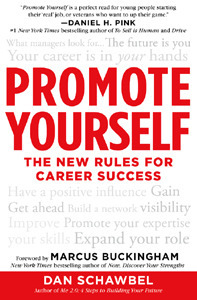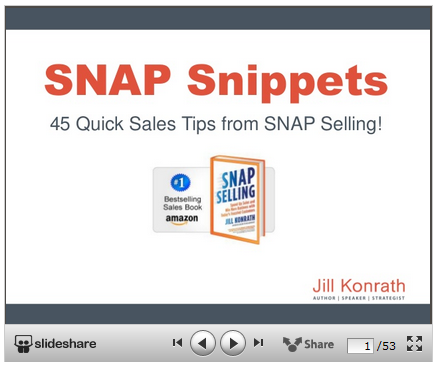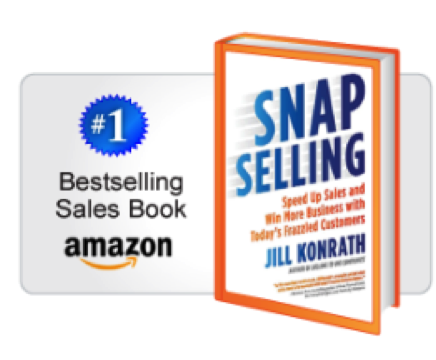Jill Konrath's Blog, page 27
September 4, 2013
New Sales Career Success Strategies
 Want to know more about what it takes to get ahead today? Then I think you'll be interested in my recent interview with Dan Schawbel, author of a Promote Yourself: The New Rules For Career Success, Gen Y career and workplace expert, and the founder of Millennial Branding. (Click here to download an excerpt.)
Want to know more about what it takes to get ahead today? Then I think you'll be interested in my recent interview with Dan Schawbel, author of a Promote Yourself: The New Rules For Career Success, Gen Y career and workplace expert, and the founder of Millennial Branding. (Click here to download an excerpt.)
JILL: Dan, thanks for talking today. You've done tons of research for your new book. What skills are employers are looking for when promoting people in their companies?
Dan Schawbel: Managers are looking for soft skills over hard skills when deciding whom to promote. The top soft skill is the ability to prioritize work, and it's important because workers have to do more with less and are given several projects to do in a limited period. As a worker, you need to decide which projects are most important to your company and then focus on it.
JILL: How important are sales skills in the hiring and promoting process today?
Dan Schawbel: If you don't have sales skills, it's hard to succeed at work because we are always selling. You have to influence those around you to take action. You have to sell yourself, your products and your ideas constantly. When you're interviewing for a job, your job is to sell the hiring manager on why you are the right candidate. If you want a promotion, you are selling them on why you earned it.
JILL: How should you go about selling yourself at work so that you don't come off as too self-promotional?
Dan Schawbel: You don't want to become too self-promotional at work because it will turn people off. Instead, you want to do your best work and let it speak for itself. You also want to shine the spotlight on your fellow co-workers because it creates stronger relationships and good karma. At the same time, you should make sure that you are getting proper credit for your work.
JILL: Do sales tactics change when marketing to different generations of people?
Dan Schawbel: Different generations respond differently to various sales tactics. For instance, if you're a financial advisor and want to get millennial clients, you're going to have to use social networks in order to reach them and serve them. They are looking for more interaction through technology. For boomers, you're going to want to have in person vs. online conversations.
JILL: Can you give us your top three career tips for salespeople?
Dan Schawbel: Absolutely. 1) Build a strong network so it doesn't feel like your blind selling. It's much easier to sell to friends than to strangers. 2) Find mentors in your company that are great at sales and try to mimic their success and get guidance on how you can improve. 3) Don't give up on your sales career because you aren't getting returned calls. It happens to everyone so just accept it and move on.
JILL: So Dan, what would you say is the biggest take away from your book?
Dan Schawbel: The biggest take away from my book is that you can't rely on anything or anyone and that you have to be accountable for your career and take charge of your life. You need to be able to adapt to change, be open to new opportunities and learn the skills you need today and in the future. At the end of the day, success lies in your hands - so go make things happen!
JILL: Thanks a million for your insights, Dan. Your book, Promote Yourself, is well worth the read for people who are looking for the new rules for sales career success. And, if you'd like to read an excerpt first, click here for Chapter 10.
Also, Dan is doing a free webcast on September 10th to promote his new book. Click here to register for The New Rules of Career Success. Please note, there is limited seating!
________________
 Dan Schawbel is the Managing Partner of Millennial Branding, a Gen Y research and consulting firm. He is the author of the newly released book, Promote Yourself: The New Rules For Career Success as well as #1 international bestselling book, Me 2.0: 4 Steps to Building Your Future.
Dan Schawbel is the Managing Partner of Millennial Branding, a Gen Y research and consulting firm. He is the author of the newly released book, Promote Yourself: The New Rules For Career Success as well as #1 international bestselling book, Me 2.0: 4 Steps to Building Your Future.
Dan is a columnist at both TIME and FORBES, and has been featured in over 1,000 media outlets. He’s spoken at Google, NBC Universal, Harvard Business School, MIT, and IBM. Dan was named to the Inc. Magazine 30 Under 30 List in 2010, the Forbes Magazine 30 Under 30 List in 2012.






August 30, 2013
3 Trade Show Strategies That Maximize Sales Potential
Today's post from the Chamber of Commerce features business-growth advice for small companies.
 When it comes to the trade shows, Susan Friedmann says that most companies have the wrong attitude.
When it comes to the trade shows, Susan Friedmann says that most companies have the wrong attitude.
“Companies, and individual employees, see trade shows as a necessary evil,” Friedmann, better known as The Trade Show Coach, said. “They don’t view a trade show as part of an overall marketing plan.”
As a trade show expert, Friedmann is invited by companies and trade show organizers to help exhibitors make the most of the events. She recently created an online trade show training program too, designed to prepare attendees to take advantage of the many opportunities the events provide.
In her experience, she has found that people are perhaps the least-utilized component of trade show marketing.
“Companies spend hundreds, thousands even, on prettying up their booths, when really there should be more focus on the people manning that booth,” Freidman said. “It is the people who will make the sales, not the booth.”
She also has this advice to help companies maximize trade show potential for sales:
1. Go for the right reasons. Friedmann says that the “lamest” reason to attend a trade show is simply because competitors will be there. “There is something to be said for having a presence, but don’t make that the only point of going,” she said.
Instead, develop specific goals and outcomes for the trade show and put the steps in place to accomplish them. Showing up the competition should just be a bonus.
2. Prepare. There are some challenging circumstances that are out of the control of exhibitors, like disastrous weather conditions or the booth pieces arriving late. For the most part though, companies attending trade shows should prepare for as many details as possible. What questions are booth visitors likely to ask? How can employees best take advantage of conversations with booth visitors?
Companies should also set at least some appointments ahead of time and invite people to stop by the booth at trade show opening events and mixers.
3. Don’t waste time. Friedmann says that the site of people simply sitting at a trade show booth – eating, reading or having conversations with colleagues – is all too common. She says that the main reason people do not take advantage of all trade show opportunities is because they do not know any better.
“People often do not know why they are there, or what is expected of them,” Friedmann said. Employers need to empower exhibitors with the pre-determined goals and the authority to make them reality. Take advantage of every opportunity to make a good impression and every sales strategy.
“Gearing up for a trade show is like putting together a giant jigsaw puzzle,” she said. “Pieces can come up missing, but companies should do their best in advance to make it all fits together to their advantage.”
Attending trade shows makes sense for businesses, just make sure you approach it with the right attitude and come prepared. What tips have helped boost your effectiveness at trade shows?
Katie Parsons writes for ChamberofCommerce.com where she specializes in business news affecting major markets. ChamberofCommerce.com helps small businesses with online growth. Plus, it facilitates connectivity between local firms and over 7,000 Chambers worldwide.






August 29, 2013
The Fastest Way to Learn How To Sell
Here's a simple, but highly effective sales strategy with a big payback for you. The first time I ever did it was very early in my career. My boss instructed me to go on a sales call with Alice -- a trainee who’d stumbled onto a big opportunity -- and teach her how to beat the competitors.
[image error]Aargh! I wasn't ready for that. I didn’t know much about the other vendors, but I knew we needed to win. Plus, I didn't want to look stupid in front of a trainee.
For the next two days, I immersed myself learning everything I could about the competition. I studied how they stacked up against us. I talked to experienced reps to find out about pricing and strategy. Finally, I figured out how to engage the prospect in a conversation that made us the obvious choice.
My head was spinning. Before we went to the meeting, I reviewed everything with Alice. I outlined competitive strengths and weaknesses. I overviewed our plan for the meeting. Then answered her questions.
After that, we went to their office. Inside, I was a nervous wreck. Fortunately, it didn't show. Two hours later we walked out with a signed contract. I was never so relieved in my whole life.
Here’s what teaching Alice did for me. I became an overnight expert in two competitors. I pulled together a rock solid, step-by-step strategy for the meeting. I figured out how to explain what I was doing to a rookie -- and why.
As a result, I leapfrogged in my own sales development. I know it seems strange to recommend teaching while you’re still learning yourself, but the benefits are huge.
As Seneca, a Roman philosopher, wrote over 2000 years ago, “By teaching, we learn.”
Annie Murphy Paul, author of Brilliant: The Science of Smart writes about a University of Pennsylvania program in which learners are responsible for teaching a specific subject to a computerized character. She states that,
“As they prepare to teach, they organize their knowledge, improving their own understanding and recall.”
Doing this helps them find gaps in their own learning too. Plus, they’re more motivated to master the material. That’s exactly what happened to me. Teaching does that to you.
So here's my challenge to you. What do you really want to (or need to) learn about in more depth right now? And, who can you teach it to?
Look around. Get creative. But most of all, start teaching so you can quickly learn how to be a top seller.






August 28, 2013
FREE Webinar: 5 Strategies to Jumpstart Your Sales
 Recently, I recorded a webinar explaining 5 tactics designed to increase your sales. In 39 short minutes, I covered such topics as:
Recently, I recorded a webinar explaining 5 tactics designed to increase your sales. In 39 short minutes, I covered such topics as:
Transforming your average prospecting calls into client-creating conversations.
Reducing the number of clients that you lose to 'no decision'.
Streamlining prospects through your pipeline.
Creating more time for activities that develop sales.
Generating more business from the clients you already have.
The webinar, 5 Strategies to Jumpstart Your Sales, can be replayed for free by clicking here. Don't keep struggling with stagnant sales - listen to the webinar to learn how to keep the sales momentum.






August 20, 2013
[Video] 5 Things New Prospects Expect To Find On Your Website
How critical is a website for prospecting? If you're a small business and wondering if it's worth it, let me tell you right now: it is vitally important.
First of all, if a prospect is willing to meet with you, they will check it out. If your website looks dated or cheap, you will lose credibility immediately. If it's filled with all sorts of gobbledy-gook about how great your company is or what wonderful products and services you have, you'll look like another slimy, self-serving salesperson. On the other hand, if your website is a hub of good information, you'll be perceived entirely differently. It doesn't have to cost you an arm and a leg!
Here 5 things new prospects expect to find on your website:
Articles or videos on your site that deal with issues your customers face.
Information on how to make a good decision.
Customer testimonials on video.
ROI calculators and case studies.
Links to good resources.
There are tons of things you can do to help your customers achieve their business objectives. Think of your website that way - not as a brochure about how great you are, but as a repository of great information.
Focus it on expertise and that's how you'll really stand out.







August 14, 2013
2 Elevator Speech Examples - One Works, the Other Doesn't
 There are multitudes of ways to answer the question "What do you do?". Your answer has the power to make or break your opportunity with a potential client.
There are multitudes of ways to answer the question "What do you do?". Your answer has the power to make or break your opportunity with a potential client.
Below are two different elevator speeches I've seen salespeople use: one method repels prospects, while the other entices them.
The Impresser: How to Repel Prospects
The Impresser wants to set himself apart – no, above – others. His elevator speech sounds like this:
“I work with only the best companies in the industry. Elite Enterprises and SNOB are my biggest customers. I work closely with their CEO, Terry Gucci. I’m sure you’ve heard of her. We handle their COQS financial systems, specifically in the re-arbitration of the micro-funding from their international and intergalactic commercial markets.”
Impressed? You should be, because the Impresser goes to great lengths to ensure you understand just how important he is. High-falluting words and industry-specific acronyms fill his elevator speech. Also, you’ll hear lots of name-dropping; well-known people and top-notch companies are part of the repertoire.
The trouble with the Impresser’s elevator speech is that it’s off-putting. Most people don’t like the implications of intellectual superiority or elitism. They’re intimidated by the big words and won’t ask questions that might make them look stupid. Again, another elevator speech that doesn’t deliver results.
The Attractor: How to Entice Prospects
The Attractor’s elevator speech is magnetic to the right listeners because it’s focused on their needs, issues and concerns. Here are several examples:
- “I work with people who are struggling to sell their products or services into large corporate accounts.”
- “I help small businesses win big contracts with large corporate customers.”
- “I help technology companies who struggle launching important new products into the market and want to improve their time-to-profitability.”
These are some of the different Attractor elevator speeches I have used. Each one of them has been successful for me. They all invite and stimulate further discussion – which is exactly what I want!
You can download my ebook, Attracting More Customers, to learn more about elevator speeches.






August 12, 2013
[Video] The Top 4 Sales Rules All Salespeople Should Know
Your prospect today can't handle much complexity, so you can easily throw them into overwhelm when you give them too much information at one time. If it's hard for them to decipher the business value of your product or service, they'll just forget about it.
Speaking of forgetting, crazy-busy people are forgetful. They forget that they're going to get back to you. They forget that they were going to organize a meeting. That's what being frazzled does to you.
Crazy-busy people subscribe to the philosophy that "if it's not broken, why fix it?" That means you'll have to work really hard to ensure they understand how much better, from a business value perspective, things will be if they work with your company.
Finally, crazy-busy prospects think you and your competitors are near clones of each other. To them, any differences are minutia and any advantages are temporary. This makes it a lot more challenging to differentiate yourself and keep out of price battles - but it can be done if you focus on the 4 SNAP sales rules throughout the entire sales process.
Top 4 Sales Rules
Remember to...
Keep it simple.
Be invaluable.
Always align with their business objectives.
Raise priorities.
Think about it. That's what works today.







August 8, 2013
Increase Sales with SNAP Snippets
Want to engage crazy-busy prospects?
These 45 quick tips from my book Snap Selling will give you fresh ideas you can start implementing today to increase sales. It's a super fast read because I know you're crazy-busy too!








August 5, 2013
[Video] You Can't Lose With This Old-Time Sales Tip
If I could show you a way to increase your lifetime income by over $1 million dollars, would you be interested? How about if I could show you a way to live 9 years longer and be healthier at the same time? Would that capture your attention?
I know those are old-time sales questions – and I’m not trying to set you up. There really is a simple way to make all that a reality. Be happy! Be happy with who you are and with what you already have.
According to Marci Shimoff, author of Happy for No Reason, “Your success won’t make you happy. Your happiness will make you successful.” And you know what? Research supports this statement.
Why am I telling you this? Because so many people have it backwards. They think they’ll be happy when they make $150,000 – yet when they do, it’s not sufficient. They think they’ll be happy when they drive the BMW – yet their happiness is short-lived.
But when you focus on loving what do, appreciating what you have and enjoying your relationships – you can be happy today. And, believe it or not, that happiness actually helps you achieve those otherwise elusive goals. Give it try! There’s no way you can lose with this sales tip.






July 31, 2013
Example of a Sales Pitch Style Prospects Can't Stand
Answering the question "What do you do?" seems like it would be easy, but it's more difficult than you think - especially if you haven't put much thought into how you would respond. Here's one common sales pitch example that will send prospects running for the hills.
The Rambler Sales Pitch
 Much as I dearly love most Ramblers, they do drive me (and most everyone else) crazy. As you can imagine, Ramblers babble on-and-on, seemingly unaware of their affect on prospective buyers. Based on my observations, there are two types of Ramblers.
Much as I dearly love most Ramblers, they do drive me (and most everyone else) crazy. As you can imagine, Ramblers babble on-and-on, seemingly unaware of their affect on prospective buyers. Based on my observations, there are two types of Ramblers.
1. Floundering-For-My-Niche Ramblers
These Ramblers lack a clear target market and value proposition. Their response to the “What do you do?” question is usually lengthy and scatter-brained.
Example of their sales pitch: “I do a lot of things. I’ve done lots of sales training in the past. But lately lots of my customers have been asking me to do facilitation. I’m really good at helping companies launch new products.
"Sometimes I write their marketing copy; sometimes I do PR. It really doesn’t matter. I like doing both – and I'm good at both. I’m doing this neat project right now for a client – it’s mapping the various futures for their markets so I’m into strategy development too.”
Why it’s a problem: The floundering Ramblers share everything they can do – hoping that something they say piques your interest. They don’t want to close down any opportunity to generate revenue. Unfortunately, their sales pitch has just the opposite affect. People much prefer to work with specialists. Also, what these Ramblers don’t know is that they project a sense of desperation and ‘lost-ness’ that’s unattractive to most all buyers.
2. I-Love-My-Subject Ramblers
Ask these Ramblers what they do and you’ll wish you never had. Typically they’re highly involved with their products or processes –and really love them. When they start talking, they don’t want to stop.
Example of their sales pitch: “We do process re-engineering with the various department, divisions, business units and subsidiaries from organizations as well as the numerous contractors that provide products and services that go into the development of your own branded and unbranded products. We initially start by doing a comprehensive assessment of the multiple groups involved in the process, covering questions such as …”
Why it’s a problem: Boring! While these Ramblers are certainly specialists, they say so much that you don’t know what’s important or relevant in their sales pitch. And the last thing you want to do is ask them another question because they may bore you to tears.
How do you answer when someone asks you what you do? Are you rambling on with out purpose, or do you have a clear and concise plan on what to say? Take the time to create your best sales pitch - it will open the door to many more sales opportunities.
Download my Attracting More Customers ebook to discover how to tell prospects what you do in a compelling manner instead of driving them away.






Jill Konrath's Blog
- Jill Konrath's profile
- 28 followers



